
Table of Contents
Scientific Classification
- Kingdom: Animalia
- Phylum: Chordata
- Class: Reptilia
- Order: Squamata
- Family: Varanidae
- Genus: Varanus
- Species: V. komodoensis
Quick Overview
The Komodo Dragon (Varanus komodoensis), recognized as the world’s largest living lizard, is an apex predator primarily found on the Indonesian islands of Komodo, Rinca, Flores, and Gili Motang. With its impressive stature, potent claws, and an acute sense of smell, it reigns supreme in its native environment.
Fast Facts
- Scientific Name: Varanus komodoensis
- Lifespan: Approximately 30 years in the wild; can live longer in captivity with proper care.
- Average Size: 8-10 feet, including tail.
- Diet: Carnivorous.
- Habitat: Dry open grasslands, savannahs, and tropical forests on select Indonesian islands.
Did you know?
A single meal can account for up to 80% of a Komodo Dragon’s body weight.
Appearance
Komodo Dragons showcase a spectrum of colors, ranging from vibrant green and grey to occasional orange hues. Their textured scales, prominent dewlap, spine-lined back, and extensive tail contribute to their unique appearance.
Size and Weight
Adult Komodo Dragons can stretch from 8 to 10 feet from snout to tail tip. They can weigh well over 200 pounds, with males generally outweighing females.
Temperament and Behavior
These reptiles are solitary and territorial. As apex predators, adult Komodos face few threats in their habitat but can exhibit aggression, especially during feeding or breeding periods.
Fun Fact:
Komodo Dragons produce venom that, when introduced via a bite, can lead to anticoagulation, promoting continued bleeding in the victim.
Habitat and Distribution
Endemic to a select few Indonesian islands, including Komodo and Rinca, these lizards prefer habitats spanning open grasslands, savannahs, and tropical forests. There have been rare instances of Komodo Dragons being found outside their native range due to individual releases or escapes.
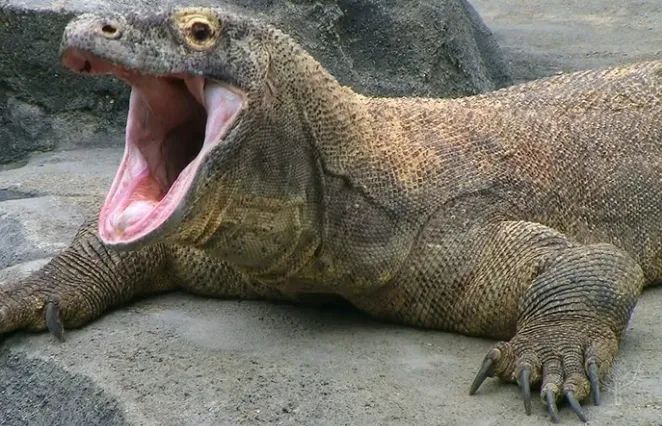
Diet and Nutrition
As apex predators, Komodo Dragons can prey on sizable animals, including deer, pigs, and smaller dragons. However, they predominantly feed on carrion, with their sharp sense of smell enabling them to locate dead animals from miles away.
Health and Wellness
Wild Komodos can sustain injuries from territorial disputes or hunting, which might lead to infections. In captivity, they’re susceptible to respiratory diseases and metabolic bone conditions. Their robust immune systems, however, enable them to flourish in environments teeming with bacteria.
Breeding
Komodo Dragons reproduce via laying eggs. After mating, females produce clutches that typically contain between 20-40 eggs. These eggs are buried in sandy or loamy substrates, with incubation periods varying, often between 90-120 days, contingent on environmental factors.
Conservation Status
Designated as “Vulnerable” by the IUCN, Komodo Dragons are imperiled mainly by habitat destruction, a reduction in prey, and certain human activities. Conservation initiatives are ongoing to protect these magnificent creatures.
Fun Fact:
Juvenile Komodo Dragons spend significant time in trees to avoid predation by adults. During this period, their diet mainly consists of insects, birds, and smaller mammals.
Photo Gallery
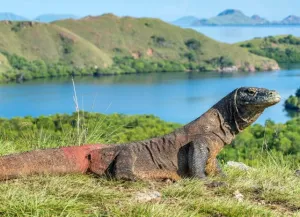
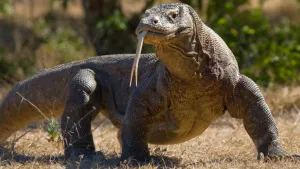
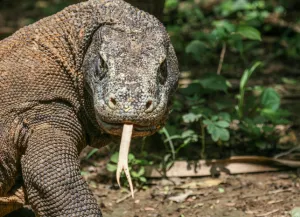
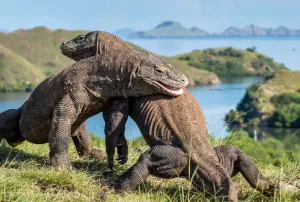
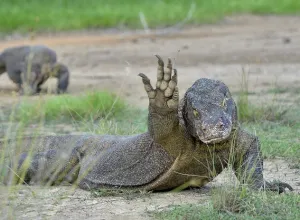
Check out the video below of a Komodo Dragon in the wild:
Related Profiles
- Frilled Lizard
- Green Iguana
Share This Profile:
3 Amazing Facts About Komodo Dragon
- Venom Over Bacteria: Recent studies suggest that Komodo Dragons have venom glands. Their venom contains compounds that prevent blood clotting in its prey, leading to shock and promoting hemorrhage.
- Superior Sensory Abilities: Their forked tongues, adept at collecting airborne molecules, empower Komodo Dragons to detect carrion from several kilometers away.
- Miraculous Reproduction: On rare occasions, female Komodo Dragons can reproduce via parthenogenesis, laying and hatching viable eggs without male fertilization.
- Enchi Ball Python: A Unique and Stunning Morph of Python regius - March 27, 2025
- Emerald Tree Monitor: The Enigmatic Green Guardian of the Rainforest - March 26, 2025
- The Egyptian Cobra (Naja haje): A Fascinating Serpent - March 25, 2025
